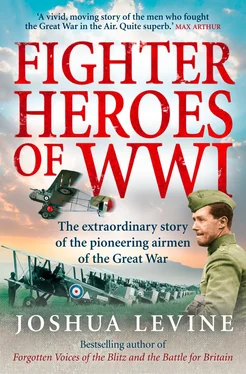A Flying Start
It is an extraordinary fact that, of the 14,166 pilots who lost their lives during the Great War, well over half were killed in training. Even without the obvious perils of combat, flying was a dangerous activity. In the years before the war, it had been even more so. Aircraft had been underpowered and slow. They were too fragile to risk being thrown around the sky, and flying – even for the thrill-seekers who pursued it – was usually more of a struggle to remain in control, than a dynamic effort to push the aircraft’s limits. Simply maintaining straight and level flight placed considerable strain on flying wires. When coming in to land, early pilots would push the nose of the aircraft down and lose height with the engine running. Their turns would be made flat, with the minimum of bank. Flying was hazardous enough, without seeking to add to the dangers.
There were those, of course, who sought greater thrills. Intrepid individuals competed in circuit races, where they would fly close to the ground and race around pylons, attempting to overtake each other. It was only on 25 September 1913, however, that British aviators were shown the true potential of their craft. On that day, a French airman named Adolphe Pégoud came to Brooklands Aerodrome to give a flying demonstration. Placing terrible strain on his Blériot monoplane, he performed a vertical dive, a tail slide and a loop. The public was inspired and so were fellow pilots. Gustav Hamel, the first man to carry airmail, wrote that ‘Pégoud’s flights have given us all a new confidence’. Confidence might have been misplaced, however. Eleven months later, Hamel died in a flying accident, and less than two years after that, Pégoud was killed in combat – by a German pilot whom he had taught to fly before the war.
For men entering the infant flying services, loops and tail slides lay in the future. First, they would have to master the basics of flight. Very few of them ever forgot their first trip in a heavier-than-air machine. Ronald Sykes, who was taught to fly by the Royal Naval Air Service in 1917, might speak for thousands:
I remember every minute of my first flight. Going round, feeling as though the world was whizzing – it was a terrific thrill. The great surprise was the effect of centrifugal force. When we were doing a sharp turn and the aeroplane was on its side, there was a pressure on me that pushed my head into the seat. That was a shock – I wasn’t expecting it. On another turn, I couldn’t lift my feet off the bottom of the aeroplane. After that, I did nothing but think about flying.
Nowadays, we are blasé about flying. The idea of looking down on the earth from a great height holds little wonder for the package tourist. During the Great War, however, for men such as Ernest Tomkins it was an unimaginable novelty:
It’s a very funny thing. Say you look down over the Clifton Suspension Bridge, you’re a little bit scared of the height. But when you get up high in an aircraft, you’re detached from the earth and you don’t realize you’re so high. You don’t feel a bit ‘windy’ about being up that high. Even getting on top of a house and looking down gives you more sense of height than if you’re up at 20,000 feet. It’s like you’re looking at a map.
Until late 1914, men joining the Royal Flying Corps had to pay for their own tuition. They attended the civilian flying schools where they trained on some very primitive machines. In October 1914, Graham Donald trained on the most primitive:
I got started training on a genuine American Wright Biplane with twin propellers, chain driven – one of them with a cross chain which makes most engineers shudder. It was completely, inherently unstable and a lot of people said that if you could fly a Wright Biplane you could fly anything. Well the fact remains that it flew. The speed range was about three knots: it flew level at 43 knots, began diving at 42 and stalled at 39 or 40. So you hadn’t got very much to play with. The instrumentation was simple – there was a length of fine cord about eighteen inches long tied to one of the struts in front of you. You kept your eye on these cords, the idea being that if they went sideways you were sideslipping. If the chord went limp, the only thing to do was to start singing ‘Nearer My God To Thee’…
In these basic machines, there was room for only one pilot. The instructor might give the novice some guidance, but essentially he was on his own. This method of training, known as the ‘French School’, was used to teach Eric Furlong to fly a Caudron, at the same school at which Donald Clappen, from the last chapter, was an instructor:
I learnt to fly at Hendon in 1914 at the Hall School of Flying. I learnt on Caudrons. The Caudron was a small aeroplane with a nacelle rather than a cockpit. A nacelle was rather like a wooden bath that you sat in and the engine was stuck in front of you. There were open booms to the tail rather than a fuselage. It only had 35 horse-power and we used to say that if one horse died, you did, too. In fact the stall point and the maximum speed were very nearly the same. The engine was going flat out all the time you were flying and if it stopped for a fraction of a second, the machine came down as though you were falling down stairs. One thing I remember – the Caudron burnt neat castor oil and the pupil inhaled a good deal of it with the result that we all needed to go to the lavatory constantly.
At first, you were strapped into the nacelle and told about the engine and the rudder and told to keep the control stick in the centre. At Hendon, there was a white patch on the fence at the far side. I was told to taxi the Caudron over to the fence. The Caudron was extremely difficult to steer. The two booms at the tail made it want to run in one direction only and the only way to steer it was to give a burst of throttle, which lifted the tail and allowed you to swing it a bit with the rudder. Invariably you swung it too far and you made your way across the aerodrome in a shocking series of S turns. Eventually you got the hang of it until one day – to your great surprise and consternation – you kept the engine on longer than you were expected to and suddenly you were in the air. You felt as though you were fifty feet up – in fact you were probably three feet up. So you stopped the engine until you were on the ground again. After that, the instructor would tear you to ribbons but he didn’t mean it because you’d done a fairly straight flight and you’d landed all right. So then he’d tell you to go and do the same thing again. And as you got used to flying at five or six feet high, you gradually kept the engine on a bit longer and pulled the stick back a bit further and you got up higher until you were up to about fifty feet. And you’d go up and down the airfield, straight down the middle.
When you got that comfortably wrapped up, you’d try a turn. You would start off on the ground with the aeroplane at forty-five degrees to the white patch on the fence and you’d take off and when you’d levelled out at fifty to a hundred feet, you kicked on the rudder, which spoiled the aerodynamic state of the aeroplane and it dropped its nose and turned. It came as a shock because it felt like putting a brake on. The machine did a right-angled turn and down you went and landed. And you kept doing this, turning to one side and then the other, until you’d got it wrapped up. Nowadays, of course, one would be told to put on bank when turning, but at that time, the instructors knew nothing about aerodynamics. There was never any banking taught. So we were told to keep our turns absolutely flat, suicidal as it sounds. And after that you were allowed to struggle around the circuit. You sort of flew around the outside of the airfield and when you came back to where you started, you shut off the engine and landed. That was a circuit. And that’s how I learned to fly.
Читать дальше












